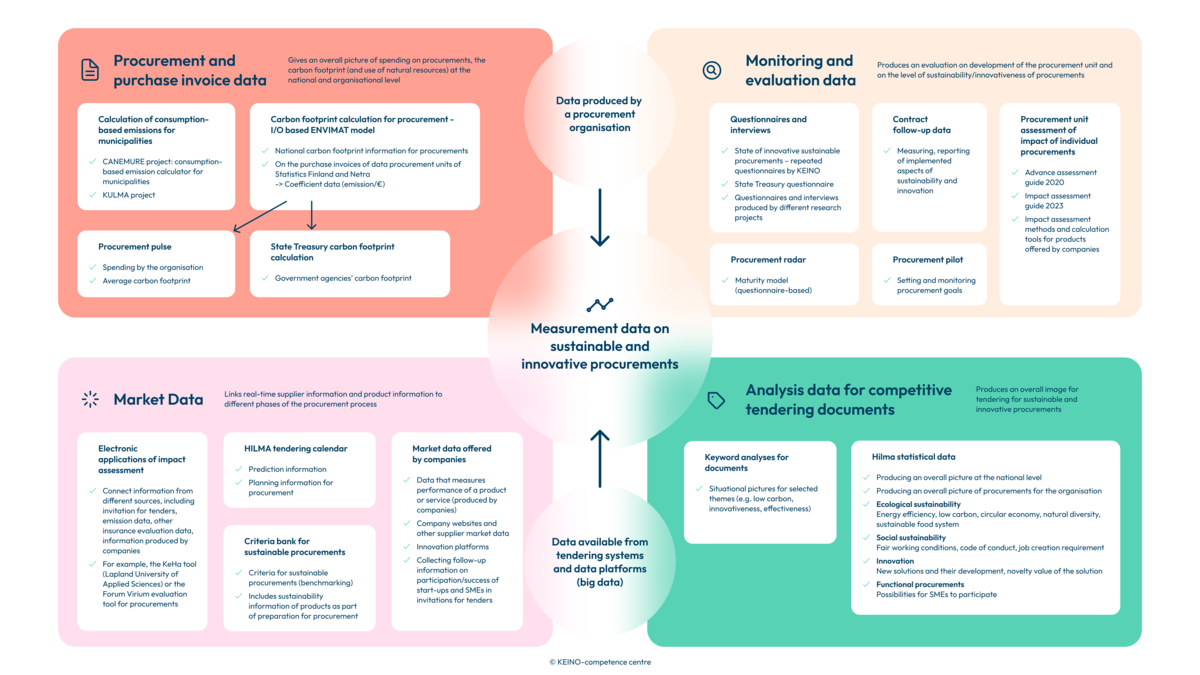
Measuring and evaluating impacts
Measuring sustainable and innovative procurements is important in order to assess the share of sustainable and/or innovative procurements. The development of the information sources and methods of measurement allow for better evaluation of the impacts procurements have and for foreseeing the direction of development.
Measuring and evaluating impacts
Click here to see a bigger version of the image (pdf)
Information sources for measuring
Methods of measurement and tools for evaluating the impacts can be utilised to produce information at the national, organisational, or procurement-case levels.
The infrastructure for measuring public procurements includes methods of measurement based on different sources of information which enable the collection and utilisation of diverse measurement information. Some of the most important sources of information include purchase invoice data and information from follow-ups and reporting collected from procurement units that is often compiled through questionnaires and interviews. Information can also be collected directly from various platforms, databases, or the internet. This kind of information includes, for example, the content of tendering documents or web-based market or product information.
Follow-up and evaluation data produced by the procurement organisation
Questionnaires and interviews, procurement units’ follow-up data:
- Produce information on development occurring in procurement units and on the skills and knowledge there. For example, on the management of sustainable and innovative procurements and strategy, market dialogue that has taken place, as well as the phases of the procurement process.
- Produce information on the deployment of sustainable solutions or the level of sustainability or innovativeness in procurements in a specific sector, i.e., examples of best practices.
- Enable more detailed evaluation of the impacts of procurements if the procurement unit monitors and reports on procurement contracts and their impacts on individual organisations.
Guides and tools for impact evaluation
Offer procurement units the possibility to evaluate procurements and investments in advance and to evaluate the impacts of procurements that have already occurred.
Help procurement units collect information on the most substantial impacts on sustainability and innovation and to consider these when making procurements.
Hankintatutka - Procurement radar
- A procurement radar (Hankintatutka, developed by Hansel Ltd) helps an organisation evaluate the maturity of its procurement operations.
- With its help it is possible to identify the key targets for development and to evaluate the good practices of the procurement branch from the point of view of the various stakeholders and in relation to other organisations.
Hankintaluotsi - Procurement pilot
- A procurement pilot (Hankintaluotsi, developed by Hansel Ltd) helps in designing the goals of procurement and to combine them with competitive tendering.
- Enables the monitoring of the achievement of goals in procurements.
Data based on procurements and purchase invoices
- Produce an overall survey of the carbon footprint of Finland's public procurements and the use of raw materials based on the ENVIMAT input-output model, targeting the types of procurement expenses of public procurement organisations derived from data on purchase invoices. The purchase invoice data is collected from Statistics Finland and for national government procurements, from Netra, which procurement units report to.
- Produces a comprehensive picture of the most significant public procurements from a low-carbon point of view.
- Procurement Pulse (Hankintapulssi, developed by Hansel Ltd) helps to calculate what an organisation spends on procurements, and the carbon footprint, whose calculations are based on coefficients of the ENVIMAT model. Purchase invoice data is available directly from the procurement data unit.
- The data bank of the Finnish State Treasury helps calculate the carbon footprint of government agencies.
- The consumption-based climate emissions from Finnish municipalities and regions for public procurements and investments (CANEMURE project).
Analysis information of documents available from tendering systems
Key word analyses of documents
- Give a comprehensive picture of the sustainability or innovation criteria of bids.
- Enable the measurement of certain subsystems or detailed goals from an extensive set of material, for example, low-carbon, innovativeness, effectiveness.
- Enable a cost-effective way to measure and follow criteria from an extensive set of material contained in invitations for tenders.
HILMA statistical information questions
- Produce an overall picture on a national level of whether certain goals of the Hankinta Suomi action plan (including energy efficiency, low carbon output, circular economy, diversity, a sustainable food system, innovativeness, social aspects, and small and medium-sized enterprises)
- Enable annual follow-ups from an extensive set of data.
Market information available from platforms and systems
- Supplier market information, criteria and innovation platforms
- Collects and links available supplier market information with the procurement process, for example on company websites or benchmarking and innovation platforms.
- Criteria banks and platforms produce information on sustainability criteria and options in real time. For example, KEINO, which is now under development, and the Motiva criteria bank for sustainable procurement.
- Enables the collection of follow-up information on the participation of companies in procurements.
- Enables the development of measuring in a way that makes it possible for artificial intelligence solutions to alter the information even in extensive materials to take on a usable accurate form for the phase in the procurement process for which it is appropriate.
HILMA competitive tendering calendar
- Produces information about upcoming competitive tenders on a national level both in the municipal sector and national government agencies. Based on information from the planning stages, procurement units and potential suppliers can anticipate upcoming tenders better than before. Open marketing dialogue based on future competitive tenders also leads to more successful procurements.